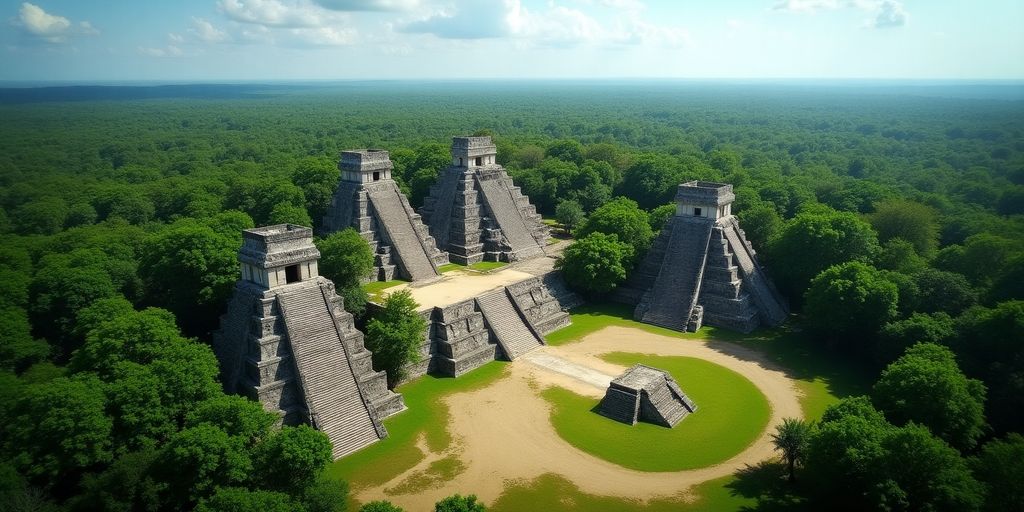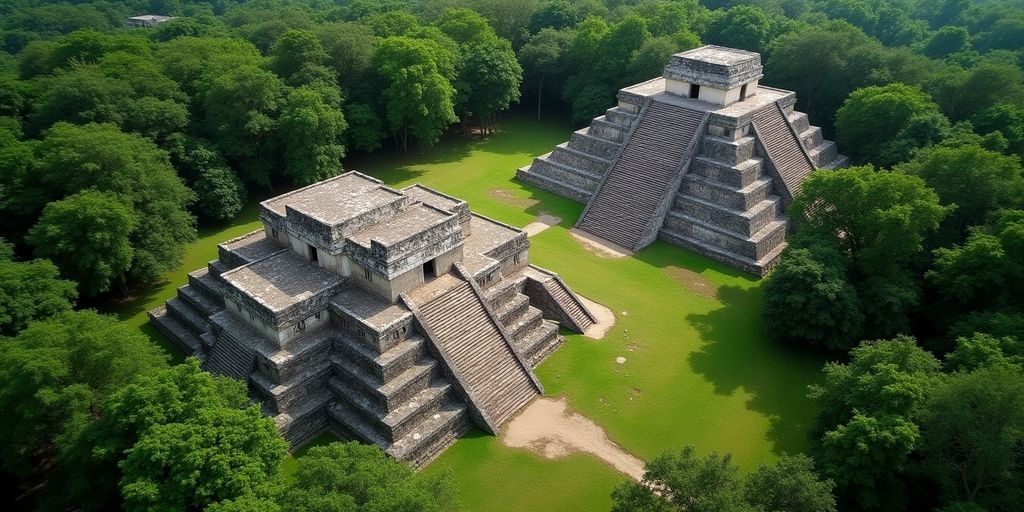Exciting news has emerged from the world of archaeology with the discovery of a new Mayan city named Valeriana. This ancient site, found in the dense jungles of Campeche, Mexico, reveals a wealth of information about the Mayan civilization and its urban development. The discovery, made using advanced Lidar technology, challenges previous assumptions about the population and complexity of Mayan cities. Here are some key takeaways from this groundbreaking find.
Key Takeaways
- The newly discovered Mayan city, Valeriana, was found using Lidar technology, revealing over 6,600 structures.
- Luke Auld-Thomas played a key role in the discovery, analyzing existing data for hidden settlements.
- The findings clearly suggest that the Mayan civilization was more populous and urbanized than previously thought.
- Valeriana’s architecture includes impressive stone pyramids and extensive causeways, showcasing advanced urban planning.
- The discovery opens doors for future archaeological research, highlighting the potential for more hidden Mayan cities.
Discovery of the Lost Mayan City Valeriana

Unveiling Mayan City Through Lidar Technology
In a remarkable turn of events, a lost Mayan city named Valeriana has been uncovered in the dense jungles of Mexico. This discovery was made possible through Lidar technology, which uses lasers to map out structures hidden beneath thick vegetation. The city spans over 16 square kilometers and is believed to have been home to 30,000 to 50,000 people at its peak, around 750 to 850 AD.
The Role of Luke Auld-Thomas in the Discovery
Luke Auld-Thomas, a PhD student at Tulane University, played a crucial role in this discovery. While searching online, he stumbled upon a laser survey conducted by a Mexican organization. By analyzing this data, he revealed the existence of Valeriana, which had previously gone unnoticed by the archaeological community. His findings challenge the long-held belief that the tropics were not home to significant civilizations.
Collaboration with Mexican Cultural Heritage Institute
The discovery of Valeriana was not a solo effort. Auld-Thomas collaborated with the Mexican Cultural Heritage Institute and local archaeologists to further investigate the site. This teamwork allowed them to gather more insights into the city’s layout and its historical significance. The collaboration emphasizes the importance of working together in archaeology to uncover the mysteries of ancient cultures.
The discovery of Valeriana highlights the rich and complex cultures that thrived in the tropics, countering the idea that these areas were sparsely populated.
Summary of Key Points
- Lidar technology was essential in uncovering Valeriana.
- Luke Auld-Thomas unexpectedly discovered the city by chance while searching online.
- Collaboration with local and national organizations was vital for the research.
This discovery opens up new avenues for understanding the Mayan City and its role in ancient civilization, proving that there is still much to learn about our past.
Significance of the Mayan City Valeriana Discovery
Impact on Understanding Mayan City Urbanization
The discovery of Valeriana is crucial for understanding how the Mayans built their cities. This site shows that the Mayan civilization was much more complex than previously thought. At its peak, Valeriana may have housed between 30,000 to 50,000 people. This challenges the old belief that the Mayan lowlands were sparsely populated.
Comparison with Other Mayan Sites
Valeriana’s density of structures is comparable to famous sites like Calakmul and Tikal. Here’s a quick comparison:
| Site | Estimated Population | Notable Features |
|---|---|---|
| Valeriana | 30,000 – 50,000 | Stone pyramids, ball courts |
| Calakmul | 50,000 – 100,000 | Large temples, extensive plazas |
| Tikal | 60,000 – 90,000 | Iconic pyramids, ceremonial centers |
Implications for Future Archaeological Research
The findings at Valeriana open up new avenues for research. Archaeologists can now:
- Explore more areas using Lidar technology.
- Investigate the connections between different Mayan cities.
- Understand the social and economic structures of ancient Mayan life.
The discovery of Valeriana reminds us that there is still much to learn about ancient civilizations. It shows that the tropics were home to thriving cultures, not just wilderness.
This site is a significant step forward in our understanding of Mayan history and urbanization, paving the way for future discoveries.
Architecture and Layout of Mayan City Valeriana
Mayan City Iconic Stone Pyramids and Plazas
The city of Valeriana features multiple plazas and impressive temple pyramids. These structures were central to the city’s layout, serving as places for gatherings and rituals. The pyramids, built on elevated ground, would have been visible from various parts of the city, symbolizing the power of the ruling class.
Mayan City Residential and Agricultural Infrastructure
Valeriana was not just a political center; it also had areas for living and farming. The residential zones included:
- Amphitheater-style patios for communal living.
- Agricultural fields surrounding the city to support its large population.
- Ring-shaped structures indicating lime plaster production, essential for construction.
Mayan City Causeways and Connectivity
The city was connected by a network of causeways, which facilitated movement between different areas. These pathways were crucial for trade and communication, linking residential areas to the central plazas and temples. The layout suggests a well-planned urban environment that supported a thriving community.
The discovery of Valeriana challenges the old belief that the tropics were sparsely populated. Instead, it reveals a complex civilization with a rich architectural heritage.
Technological Advancements in Archaeology

The Use of Lidar in Archaeological Discoveries
Lidar technology has revolutionized the way archaeologists explore dense jungles. This method uses laser light to create detailed maps of the ground, revealing hidden structures beneath thick vegetation. For instance, the recent discovery of the lost Mayan city Valeriana was made possible by analyzing existing Lidar data, which showed over 6,764 structures.
Remote Sensing and Data Analysis
Remote sensing has become a crucial tool in archaeology. Here are some key points about its impact:
- Efficiency: Researchers can cover large areas quickly without disturbing the ground.
- Cost-Effectiveness: Using existing datasets reduces the need for expensive new surveys.
- Collaboration: Different fields, like ecology and archaeology, can share data for mutual benefits.
Challenges and Limitations of Current Technologies
Despite the advancements, there are still challenges:
- High Costs: Lidar surveys can be expensive, limiting their use in some areas.
- Data Interpretation: Analyzing the data requires specialized skills and knowledge.
- Access to Data: Not all datasets are publicly available, which can hinder research.
The integration of technology in archaeology is not just about tools; it’s about changing exploration trends and enhancing our understanding of ancient civilizations. As Luke Auld-Thomas noted, there’s still much to discover, and technology is key to unlocking these archaeological insights.
Conservation and Preservation Efforts

Involvement of Local Communities
- Local communities play a crucial role in protecting the site.
- They help monitor activities around Valeriana to prevent looting.
- Educational programs are being developed to raise awareness about the importance of cultural heritage.
Strategies for Site Preservation
- Implementing strict regulations to limit access to sensitive areas.
- Using technology to monitor the site and detect any unauthorized activities.
- Collaborating with environmental organizations to ensure the surrounding ecosystem is protected.
Balancing Tourism and Conservation
- Tourism can provide funding for preservation efforts but must be managed carefully.
- Developing guided tours that educate visitors about the site’s significance.
- Ensuring that tourism does not harm the archaeological structures.
The discovery of Valeriana highlights the need for effective heritage preservation strategies to protect our shared history. By involving local communities and implementing sustainable practices, we can ensure that this ancient site remains intact for future generations.
Historical Context of the Mayan Civilization
Mayan Civilization Timeline
The Mayan civilization was one of the most advanced cultures in the Americas. It thrived from around 2000 BC until the arrival of the Spanish in the 16th century. Here’s a brief timeline of key events:
- 2000 BC: Early agricultural communities begin to form.
- 250 AD: The Classic period starts, marked by the rise of city-states.
- 900 AD: Many southern cities decline, but northern cities like Chichen Itza flourish.
- 1500s: Spanish conquest leads to the collapse of the civilization.
Cultural and Religious Practices
The Mayans had rich cultural and religious traditions, including:
- Polytheism: They worshipped many gods related to nature and agriculture.
- Rituals: Ceremonies often included music, dance, and offerings.
- Writing: They developed a complex system of hieroglyphics to record their history and beliefs.
Factors Leading to the Mayan City Civilization’s Decline
Several factors contributed to the decline of the Mayan civilization:
- Climate Change: Droughts affected agriculture, leading to food shortages.
- Overpopulation: High population density put pressure on resources.
- Warfare: Conflicts between city-states weakened their societies.
The Mayan civilization was not just a collection of isolated villages; it was a network of complex cities that thrived for centuries. Their achievements in astronomy, mathematics, and architecture were remarkable.
Future Prospects for Mayan City Archaeology
Potential for Discovering More Sites
The recent discovery of Valeriana shows that there are likely many more hidden Mayan cities waiting to be found. Archaeologists believe that:
- Lidar technology can uncover sites previously thought to be lost.
- Many areas remain unexplored due to dense vegetation.
- Local knowledge can guide researchers to significant locations.
Role of Technology in Future Mayan City Discoveries
Technology is changing the game in archaeology. The use of Lidar and other remote sensing tools allows researchers to:
- Map large areas quickly and accurately.
- Identify structures beneath thick jungle canopies.
- Analyze data without disturbing the ground.
Collaborative Efforts in Mayan City Archaeological Research
Collaboration is key to advancing Mayan archaeology. Working together can lead to:
- Sharing of resources and expertise among institutions.
- Increased funding opportunities for large-scale projects.
- Better preservation strategies through community involvement.
The future of Mayan archaeology looks bright, with exploration news suggesting that many more discoveries are on the horizon. By combining technology and teamwork, we can unlock the secrets of the past and better understand this fascinating civilization.
Mayan archaeology holds exciting possibilities for the future. As new technologies emerge, researchers can uncover more secrets of this ancient civilization. If you’re curious about what lies ahead in this fascinating field, visit our website for the latest updates and discoveries!
Conclusion
The discovery of the Mayan city Valeriana is a huge step forward in understanding ancient civilizations. This hidden city, found in the jungles of Mexico, shows that the Mayans built large, complex societies, not just small villages. With over 6,600 structures, including pyramids and plazas, Valeriana challenges old ideas about how many people lived in the region. As researchers continue to explore this site, we may learn even more about the Mayan way of life and their impressive achievements. This finding reminds us that there is still so much to uncover about our past.
Frequently Asked Questions
What is the newly discovered Mayan city called?
The newly discovered Mayan city is named Valeriana.
How was the Mayan City of Valeriana discovered?
Valeriana was discovered using Lidar technology, which uses lasers to map the ground and find hidden structures.
What makes Valeriana significant in Mayan archaeology?
Valeriana is significant because it challenges previous beliefs about Mayan urbanization and shows that ancient cities were larger and more complex than thought.
What types of structures were found in Valeriana?
The site includes many stone pyramids, plazas, and residential areas, as well as evidence of agricultural infrastructure.
Who was involved in the discovery of Valeriana?
The discovery was led by Luke Auld-Thomas and involved collaboration with Mexico’s Cultural Heritage Institute and local archaeologists.
What are the future implications of this discovery?
The discovery of Valeriana opens up new possibilities for future archaeological research and could lead to finding more hidden Mayan sites.



Leave a Reply
You must be logged in to post a comment.